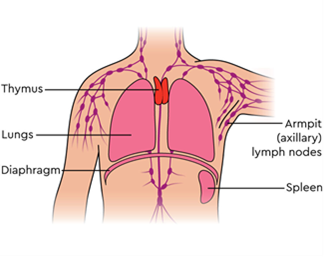When you are told you have a nodule in your lungs it can be confusing, and you may have questions. This webpage has been produced to help explain what it means to have a lung nodule, and to reassure you about what to expect.
What does ‘lung nodule’ mean?
The phrase ‘lung nodule’ describes a small, denser area of the lung which appears as a round spot on the image. Finding a nodule on a chest X-ray or CT scan is common.
Common Features:
- Often small, measuring less than 30 millimeters
- Don’t have any symptoms, and
- Do not affect the function of the lungs or interfere with breathing.
- Sometimes a lung nodule is also called a ‘pulmonary’ nodule and the two phrases mean the same thing.
How common is it to have a lung nodule?
Up to 35 percent of people who have a CT scan which includes their lungs will have a nodule found.
Sometimes it is possible to find more than one nodule in your lungs. This is not necessarily more serious than having a single nodule.
What might have caused my lung nodule?
The nodule can be due to lots of different causes. These can include:
- a small area of infection
- scarring
- normal glands within the lung
- nodules are common in people who have had previous TB
- In a small number of cases, they can be the first signs of an early cancer in the lung. If this is the case, finding them early makes them much more treatable.
How will my lung nodule be followed up?
It is not always possible to tell what a nodule represents on the very first scan. In these cases, we may offer you one or more further scans to see if the nodule changes or stays the same over a period of time.
Most lung nodules stay the same size, get smaller, or even disappear. If the nodule has not increased in size over several scans, no more follow-up is required. The majority of lung nodules do not change.
The process of repeated scans and reviewing results is sometimes called ‘nodule surveillance’ or ‘active monitoring’.
Not all lung nodules require more follow-up. We use national guidelines which have been written using evidence from clinical studies of thousands of people’s scans and their outcomes. These guidelines and the features described help us to decide what to do next with each sort of nodule, and pick out any that might need follow up.
Your doctor or specialist nurse will talk to you about your individual risk and you can always ask any questions if you have them.
Support for you and your family
If you have a scan which shows a lung nodule, a multi-disciplinary team (MDT) work together to look after you. The team might include consultant respiratory physicians, specialist trainee doctors, a consultant radiologist and a specialist nurse.
Your appointments will normally be with a respiratory physician or specialist nurse to discuss results of your scans and next plans.
These might be face to face, over the telephone, via video clinics or through letters.
If you do have worries or anxieties, especially between appointments, it’s important to talk to them about this.
Summary
Lung nodules are very common findings, and your team are there to support and work with you and to answer any questions you have. If you’d like to find out more have a look at the leaflets below.
Lung Health Checks Lung nodules leaflet - Lung nodules
Lung nodule video - www.youtube.com/watch?v=J6oyYwqTjPo



